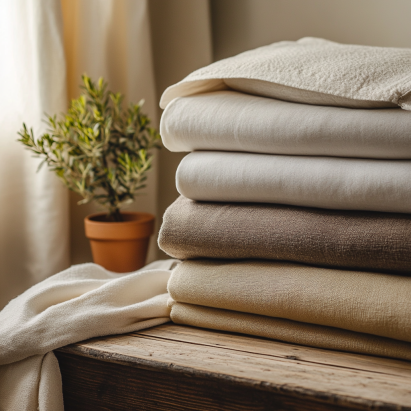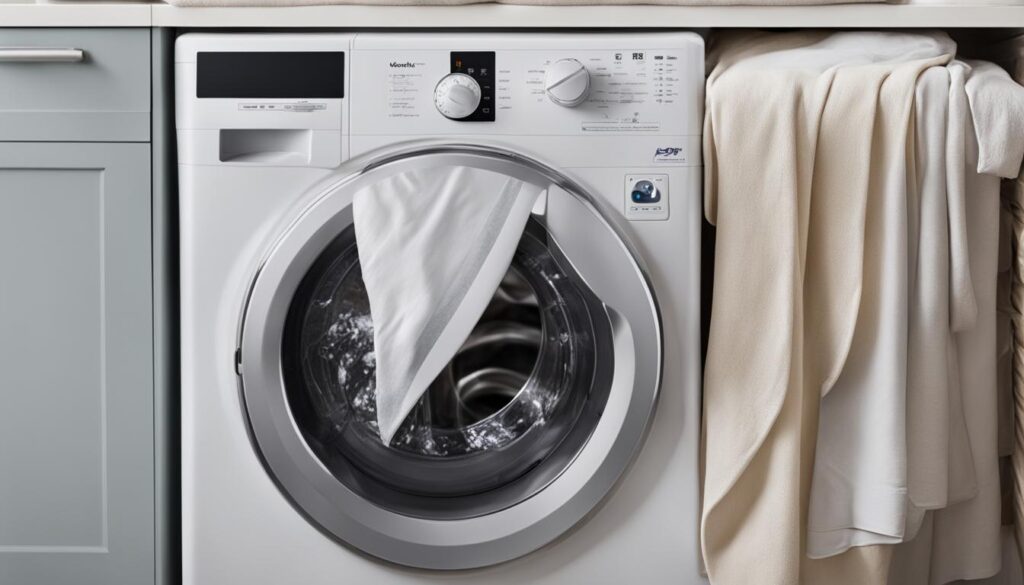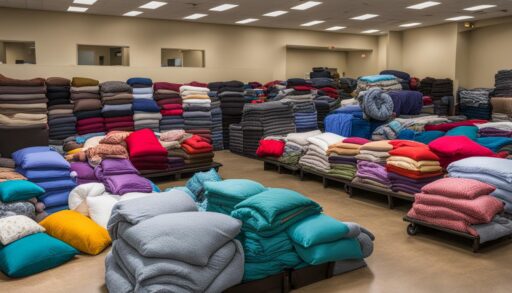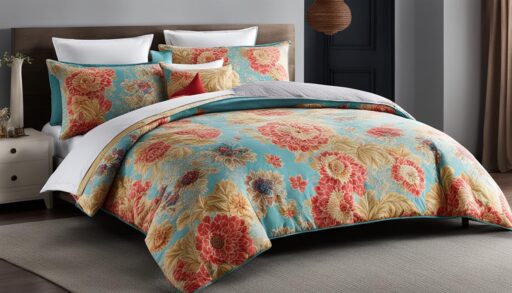Queen Bedding on a Full Bed: Compatibility and Sizing Tips
Have you ever wondered if queen bedding would fit a full-sized bed? In this article, we will explore the compatibility between queen bedding and full beds, so you can make the right choice for your sleeping needs.
Key Takeaways:
- Full mattresses measure 54 inches by 75 inches, while queen mattresses measure 60 inches by 80 inches.
- Queen bedding can technically fit a full bed but may result in excess fabric and a less than ideal fit.
- Using full sheets on a queen bed may not adequately cover the mattress and could be uncomfortable.
- Tucking the excess fabric under the mattress or using sheet straps can help minimize slipping or bunching up.
- It is recommended to use sheets specifically designed for the size of your bed to ensure a proper fit and comfortable sleep experience.
Can Full Sheets Fit a Queen Bed?
When it comes to bedding, finding the right size for your mattress is essential for a comfortable and snug sleep experience. If you have a queen-sized bed and are wondering if full sheets can fit, let’s explore the size difference between queen and full bedding and whether queen sheets can fit on a full bed.
Full sheets are designed to fit a full-sized bed, which measures 54 inches by 75 inches. In comparison, a queen bed measures 60 inches by 80 inches, making it larger than a full bed. Due to this size difference, using full sheets on a queen-sized bed may result in less coverage and potential discomfort. The fitted sheet’s elasticated corners may not sit properly on the edges of the larger mattress, leading to the sheet slipping or bunching up.
While it is technically possible to use full sheets on a queen bed, it is not recommended for an optimal sleep experience. The excess fabric from the smaller sheets may not adequately cover the larger mattress, compromising the overall look and functionality of the bedding. To ensure the best fit and comfort, it is advised to choose sheets specifically designed for the size of your bed.
Table: Queen vs. Full Bedding Dimensions
| Bed Size | Dimensions (inches) |
|---|---|
| Full | 54 x 75 |
| Queen | 60 x 80 |
How to Deal with Excess Fabric
If you find yourself using queen sheets on a full bed and dealing with excess fabric, there are a few solutions you can try. Firstly, you can tuck the excess fabric under the mattress to minimize the visible fabric and make the bed look neater. This method can help create a cleaner and more tailored appearance to the bed.
Another option is to use sheet clips or suspenders to hold the oversized sheet securely in place. These clips or suspenders can be easily attached to the corners of the sheet and the edges of the mattress, preventing the sheets from slipping or bunching up during the night. This can help ensure a more comfortable sleep experience without the annoyance of constantly adjusting the sheets.
Additionally, considering purchasing bedding specifically designed for a full bed can provide the best fit and comfort. Full-sized sheets are tailored to fit the dimensions of a full bed, eliminating the need for any adjustments or dealing with excess fabric. This can result in a more seamless and aesthetically pleasing appearance to your bed.
Overall, while using queen sheets on a full bed may result in excess fabric, there are practical solutions available to deal with this issue. Whether it’s tucking the fabric, using sheet clips, or opting for full-sized bedding, finding the best bedding for a full bed can enhance your sleep experience and maintain an attractive bed appearance.
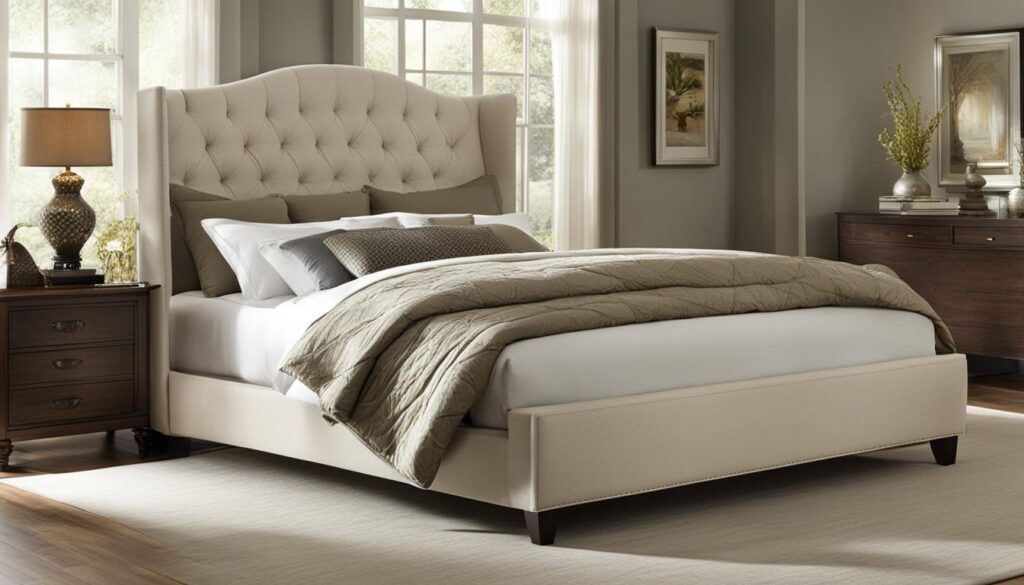
Difference Between Full and Queen Sheets
When it comes to choosing bedding for your full or queen-sized bed, it’s important to understand the differences between full and queen sheets. Full sheets are designed to fit a full-sized mattress, which measures 54 inches by 75 inches, while queen sheets are tailored for a queen-sized mattress, which measures 60 inches by 80 inches.
The main discrepancy between the two lies in their size and the amount of fabric used. Full sheets are smaller compared to queen sheets, which means they may not fully cover a queen-sized bed, resulting in less coverage and potential discomfort. The elasticated corners of a fitted full sheet may not sit properly on the edges of a queen mattress, causing the sheet to slip or bunch up.
On the other hand, using queen sheets on a full bed will result in excess fabric. While the queen sheets will technically fit the full-sized mattress, the added fabric may require extra adjustments to ensure a better fit. Tucking the excess fabric under the mattress or using sheet clips can help hold the oversized sheet securely in place, preventing it from slipping or bunching up during the night.
To ensure the best fit and a comfortable sleep environment, it is recommended to use sheets specifically designed for the size of your bed. Full sheets are ideal for single sleepers or smaller bedrooms, providing a snug and cozy sleeping experience. Queen sheets, on the other hand, are better suited for larger beds and are especially beneficial for two sleepers or those who prefer more sleeping room.
Summary:
- Full sheets are designed for a full-sized bed, while queen sheets are tailored for a queen-sized bed.
- The main difference lies in their size and the amount of fabric used.
- Using full sheets on a queen bed may result in less coverage and potential discomfort.
- Using queen sheets on a full bed will result in excess fabric that may require adjustments.
- It is recommended to use sheets specifically designed for the size of your bed to ensure a proper fit and comfortable sleep experience.
| Bed Size | Sheet Size | Fabric Dimensions |
|---|---|---|
| Full | Full sheets | 54 inches by 75 inches |
| Queen | Queen sheets | 60 inches by 80 inches |
Conclusion: Full vs Queen Size Sheets
Choosing the right sheets for your bed can make a significant difference in your sleep experience. When it comes to full and queen size beds, there are important factors to consider to ensure optimal comfort and fit.
If you have a full-sized bed, using full sheets designed specifically for this size is recommended. Full sheets will provide a snug and cozy fit, perfect for single sleepers or smaller bedrooms. However, if you choose to use queen sheets on a full bed, you may experience excess fabric. While it’s technically possible to use queen sheets on a full bed, the excess fabric may cause the sheets to slip or bunch up, leading to discomfort during the night.
On the other hand, if you have a queen-sized bed, using queen sheets is the way to go. Queen sheets are designed to fit the larger dimensions of a queen mattress, measuring 60 inches by 80 inches. These sheets offer more coverage and spaciousness, ideal for two sleepers or those who prefer more sleeping room.
Ultimately, the choice between full and queen sheets depends on the size of your bed and your personal preferences. For the best fit and comfort, it’s recommended to use sheets specifically designed for the size of your bed. By ensuring the right bedding compatibility, you can sleep soundly and wake up feeling refreshed.
FAQ
Will queen bedding fit a full?
Full and queen size mattresses have slight differences in dimensions. While queen bedding will technically fit a full bed, the excess fabric may cause the sheets to slip or bunch up. It is recommended to use sheets specifically designed for the size of your bed to ensure a proper fit and comfortable sleep experience.
Can full sheets fit a queen bed?
Full sheets are designed to fit a full-sized bed and may not adequately cover a queen-sized bed. The smaller dimensions of full sheets may result in less coverage and potential discomfort. It is not recommended to use full sheets on a queen bed for an optimal sleep experience.
How to deal with excess fabric?
If you find yourself using queen sheets on a full bed and dealing with excess fabric, you can tuck the excess fabric under the mattress to minimize visibility and make the bed look neater. Another option is to use sheet clips or suspenders to hold the oversized sheet securely in place. Considering purchasing bedding specifically designed for a full bed is also recommended for the best fit and comfort.
What is the difference between full and queen sheets?
Full sheets are tailored to fit a full-sized mattress, measuring 54 inches by 75 inches, while queen sheets are designed for a queen-sized mattress, measuring 60 inches by 80 inches. The main difference lies in their size and the amount of fabric used. It is important to choose the corresponding sheet size for the best fit and comfort.
Full or queen sheets for my bed?
Choosing between full and queen sheets depends on the size of your bed. Full sheets are better suited for single sleepers or smaller bedrooms, providing a snug and cozy sleeping experience. Queen sheets, on the other hand, offer more coverage and spaciousness, which is especially beneficial for two sleepers or those who prefer more sleeping room. Consider the dimensions of your bed and choose the corresponding sheet size accordingly.




